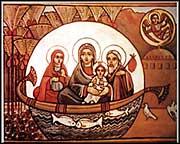
Tales of the saints Coptic Saints and Pilgrimages, Otto F A Meinardus, Cairo: American University in Cairo Press, 2002. pp113
Click to view caption
The Flight of the Holy Family, by Youssef Nassif and Boudour Latif
This small, beautifully bound and illustrated book on the Coptic tradition that goes back almost 2,000 years is Otto Meinardus's newest publication. Here, the renowned scholar moves away from the history of the Church (from its earliest days to the end of the 20th century), as covered in his widely distributed Two Thousand Years of Coptic Christianity, and examines the other side of the coin: the popular traditions and beliefs of the people. That is to say, he explores the folk religion that touched on every aspect of the personal lives of ordinary Copts: their worship of saints and martyrs, pilgrimages, dreams, visions, and women saints. He also devotes a section to recently discovered martyrs, and another to Coptic saints in an age of globalisation.
Meinardus points out that alongside the official religion with its emphasis on Orthodox doctrine and liturgy, there co-existed in Egypt a dynamic popular or folk religion that touched on every aspect of the personal and social lives of the people. Lifestyles and patterns of behaviour have given way over the millennia to new modes of living and political and social change have come in cyclic patterns, but what has nevertheless endured is deep- rooted faith and patterns of religious devotion. These have remained constant.
Take pilgrimages to holy sites, for example. Muslims and Christians alike attend many of the famous Christian pilgrimage sites, like the Church of the Holy Virgin at Gabal Al-Tayr and the Monastery of Dair Al-Muharraq in the Western Desert, because they are associated with cures. People attend to pray, offer donations to those less fortunate than themselves, and make promises and vows in the hope of a cure from physical or mental ailments. Women who want children, single people who want to get married, people who are believed to be demon possessed and wish to be exorcised call on the saints through the monks.
One chapter of this book, devoted to "Women Saints in Coptic Spirituality", outlines the positions and roles of women in the Coptic Church. Meinardus points out that, like all churches of apostolic origin, the Coptic Church of Egypt prohibits women from assuming any priestly or sacramental functions. This position, the author points out, is based on Old and New Testament verses, one of which is St Paul's statement: "As in all the churches of the saints, the women should keep silence... for they are not permitted to speak..." (1 Cor. 14: 33)
Meinardus does point out, however, that there were women monks, and he notes that in the leather-bound Coptic codices found in a cave near Nag Hammadi in Upper Egypt in 1945, is the Gospel of Thomas, an anthology of 144 "Sayings of Jesus" (logia) which scholars have assigned to the middle of the second century. One of these reads: "Let Mary go out from among us, because women are not worthy of the Life." In answer, Jesus said: "See, I shall lead her, so that I will make her male, that she too may become a living spirit, resembling you males. For every woman who makes herself male will enter the Kingdom of Heaven."
Meinardus mentions that the biographies of women monks are similar to those of men. "They were usually daughters of Roman emperors, kings, governors, or notables," he writes. "Influenced and inspired by the asceticism of the Egyptian desert fathers, the young women assumed the disguise of a courier, in the case of Hilaria, or they escaped from marriage proposals by donning male attire, as Appollinaria did. As monks -- often described as eunuchs -- they entered the desert of Scetis or Wadi Al-Natrun. They lived as hermits, each inhabiting a cell under the direction of a father..."
Coptic Saints and Pilgrimages is not a new study. Most of the material that appears in this volume has appeared in one form or another in scholarly publications. In fact, a list of the sources in which this work originally appeared is provided in the bibliography. However, it is nevertheless important in that it focusses on the popular aspects of Coptic religious devotion.
Reviewed by Jill Kamil
http://weekly.ahram.org.eg/2004/673/bo22.htm
0 Comments:
Post a Comment
<< Home